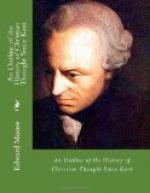Rationalism had ended in proving deadly to ideals. This was true. But men forgot for the moment how glorious an ideal it had once been to be rational and to assert the rationality of the universe. Still the time had come when, in Germany at all events, the great cry was, ’back to the ideal.’ It is curious that men always cry ‘back’ when they mean ‘forward.’ For it was not the old idealism, either religious or aesthetic, which they were seeking. It was a new one in which the sober fruits of rationalism should find place. Still, for the moment, as we have seen, the air was full of the cry, ’back to the State by divine right, back to the Church, back to the Middle Age, back to the beauty of classical antiquity.’ The poetry, the romance, the artistic criticism of this movement set themselves free at a stroke from theological bondage and from the externality of conventional ethics. It shook off the dust of the doctrinaires. It ridiculed the petty utilitarianism which had been the vogue. It had such an horizon as men had never dreamed before. It owed that horizon to the rationalism it despised. From its new elevation it surveyed all the great elements of the life of man. It saw morals and religion, language and society, along with art and itself, as the free and unconscious product through the ages, of the vitality of the human spirit. It must be said that it neither solved nor put away the ancient questions. Especially through its one-sided aestheticism it veiled that element of dualism in the world which Kant clearly saw, and we now see again, after a century which has sometimes leaned to easy pantheism. However, it led to a study of the human soul and of all its activities, which came closer to living nature than anything which the world had yet seen.
To this group of aesthetic idealists belong, not to mention lesser names, Lessing and Hamann and Winckelmann, but above all Herder and Goethe. Herder was surely the finest spirit among the elder contemporaries of Goethe. Bitterly hostile to the rationalists, he had been moved by Rousseau to enthusiasm for the free creative life of the human spirit. With Lessing he felt the worth of every art in and for itself, and the greatness of life in its own fulfilment. He sets out from the analysis of the poetic and artistic powers, the appreciation of which seemed to him to be the key to the understanding of the spiritual world. Then first he approaches the analysis of the ethical and religious feeling. All the knowledge and insight thus gained he gathers together into a history of the spiritual life of mankind. This life of the human spirit comes forth everywhere from nature, is bound to nature. It constitutes one whole with a nature which the devout soul calls God, and apprehends within itself as the secret of all that it is and does. Even in the period in which he had become passionately Christian, Herder never was able to attain to a scientific establishing of his Christianity, or to any sense of the specific aim




